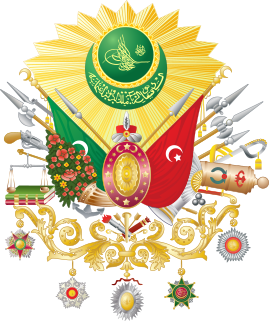 W
WOttoman cuisine is the cuisine of the Ottoman Empire and its continuation in the cuisines of Turkey, Greece, the Balkans, and parts of the Caucasus and the Middle East.
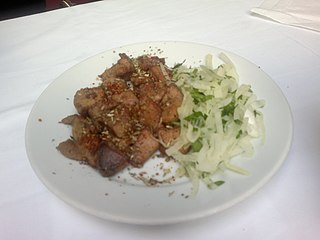 W
WArnavut ciğeri is a Turkish dish made of oil fried lamb or veal liver cubes seasoned with hot pepper served traditionally with onion and parsley.
 W
WBaklava is a rich, sweet dessert pastry made of layers of filo filled with chopped nuts and sweetened and held together with syrup, frosting or honey. It is characteristic of the cuisines of the Egypt, Levant and the broader Middle East, along with South Caucasus, Balkans, the Maghreb and Central Asia.
 W
WBasbousa is a traditional Middle Eastern sweet cake that originated in Egypt, although it is also popular in other countries. It is made from a semolina batter and cooked in a pan, then sweetened with orange flower water, rose water or simple syrup, and typically cut into diamond shapes. It is found in most former areas of the Ottoman Empire, and is featured in Middle Eastern cuisines, Greek cuisine, Azerbaijani cuisine, Turkish cuisine, and many others.
 W
WBörek is a family of baked filled pastries made of a thin flaky dough such as phyllo or yufka, typically filled with meat, cheese or vegetables. It is found in the cuisines of the Turkish cuisine, Balkans, the South Caucasus, the Levant, and other parts of Eastern Europe and Western Asia. A börek may be prepared in a large pan and cut into portions after baking, or as individual pastries. The top of the börek is occasionally sprinkled with sesame or nigella seeds.
 W
WBoza, also bosa, bozo is a fermented beverage popularly made in parts of North Africa, Central and Western Asia, Caucasus and Southeast Europe. It is a malt drink made by fermenting various grains: maize (corn) and wheat in Turkey, wheat or millet in Bulgaria and Romania, and barley in Ancient Egypt. It has a thick consistency, a low alcohol content, and a slightly acidic sweet flavor.
 W
WDolma is a family of stuffed dishes found in the Balkans, South Caucasus, Central Asia and the Middle East. Common vegetables for stuffing are tomato, pepper, onion, zucchini, eggplant and pointed gourd. Stuffed cabbage rolls and vine leaves are also very popular, which are sometimes also called sarma. Meat dolmas are generally served warm, often with tahini or avgolemono sauce. Dolmas prepared with olive oil and stuffed with rice are generally served cold with a garlic-yogurt sauce.
 W
WEkmek kadayıfı is a bread pudding that was historically part of Ottoman cuisine and in modern times remains part of the cuisines of the former Ottoman Empire. It is usually served with kaymak, a kind of clotted cream. In Turkey it is considered a regional specialty of Afyonkarahisar.
 W
WHalva are dense, sweet confections originating in the Middle East. The word is mainly used to describe two different types of desserts: a gelatinous confection made from flour, clarified butter (ghee) and sugar; or a crumbly nut-butter-based product often made from tahini and sugar. Halva may also be based on various other ingredients, including beans, lentils, and vegetables such as carrots, pumpkins, yams and squashes.
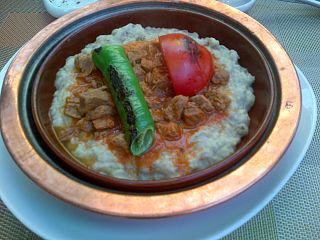 W
WHünkârbeğendi, or simply beğendi, is an Ottoman cuisine dish. It is made from smoked and spiced eggplant, which is grilled, then pureed, and stirred with milk, melted butter and roasted flour. Finally, the mixture is topped with cubes of sauteed lamb.
 W
Wİmam bayıldı is a dish in Ottoman cuisine consisting of whole eggplant stuffed with onion, garlic and tomatoes, and simmered in olive oil. It is a zeytinyağlı dish and is found in most of the former Ottoman regions. The dish is served at room temperature or warm.
 W
WIskilip dolması is a dish of caramelized onions, rice and lamb that was traditionally cooked in a cloth bag in a large copper pot or cauldron. During the Ottoman period, this dish was prepared to feed the Ottoman army. The dish is a regional specialty of Çorum, where it is prepared in large quantities using traditional methods and is typically served at weddings. Though it is not a dolma, It is called a dolma because it shares some similar features with some of the stuffed dolma dishes.
 W
WKanafeh is a traditional Middle Eastern dessert made with shredded filo pastry, or alternatively fine semolina dough, soaked in sweet, sugar-based syrup, and typically layered with cheese, or with other ingredients such as clotted cream or nuts, depending on the region. It is popular in the Arab world, particularly the Levant and Egypt, and especially among Palestinians. In addition, variants are found in Turkey, Greece, and the Balkans, as well as in the South Caucasus such as Armenia and Azerbaijan.
 W
WKebabs are various cooked meat dishes, with their origins in Middle Eastern cuisine. Many variants are popular around the world.
 W
WKeşkek, also known as Kashkak and Kashkek, is a sort of ceremonial meat or chicken and wheat or barley stew found in Turkish, Iranian and Greek cuisines.
 W
WLakerda is a pickled bonito dish eaten as a mezze in the Balkans and Middle East. Lakerda made from one-year-old bonito migrating through the Bosphorus is especially prized.
 W
WLángos or lalanga is a deep fried flatbread that can be found in Hungarian, Greek and Turkish cuisines. Historically it was present in both Byzantine and Ottoman cuisines.
 W
WMoussaka is an eggplant- and/or potato-based dish, often including ground meat, which is common in the Balkans and the Middle East, with many local and regional variations.
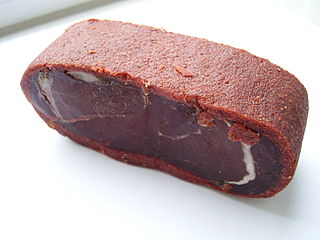 W
WPastırma or basturma, also called pastourma basdırma, as well as basterma, is a highly seasoned, air-dried cured beef that is part of the cuisines of Turkey, Macedonia, Iraq, Bulgaria, Greece, Azerbaijan and Armenia.
 W
WPekmez is a molasses-like syrup obtained after condensing juices of fruit must, especially grape by boiling it with a coagulant agent like wood ashes or ground carob seeds. It is used as a syrup or mixed with tahini for breakfast. In Azerbaijan, pekmez is also mixed with natural yogurt and consumed as a refreshment during summer time.
 W
WPilaf, pilau, pulao or polao is a rice dish or, in some regions, a wheat dish, whose recipe usually involves cooking in stock or broth, adding spices, and other ingredients such as vegetables or meat, and employing some technique for achieving cooked grains that do not adhere.
 W
WSarma is a dish of vine, cabbage, monk's rhubarb, kale or chard leaves rolled around a filling of grains, like bulgur or rice, minced meat, or both. It is found in the cuisines of the former Ottoman Empire from the Middle East to Southeastern Europe.
 W
WSimit, gevrek, bokegh, or koulouri is a circular bread, typically encrusted with sesame seeds or, less commonly, poppy, flax or sunflower seeds, found across the cuisines of the former Ottoman Empire, and the Middle East. Simit's size, crunch, chewiness, and other characteristics vary slightly by region. It is widely known as Turkish bagel in United States.
 W
WShish kebab is a popular meal of skewered and grilled cubes of meat. It is similar to or synonymous with a dish called shashlik, which is found in the Caucasus region.
 W
WStuffed peppers is a dish common in many cuisines. It consists of hollowed or halved peppers filled with any of a variety of fillings, often including meat, vegetables, cheese, rice, or sauce. The dish is usually assembled by filling the cavities of the peppers and then cooking.
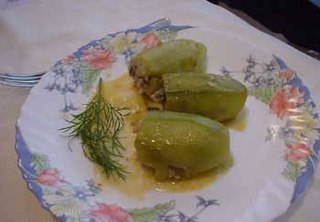 W
WStuffed squash, courgette, marrow, mahshi, or zucchini is a dish of the region of the former Ottoman Empire from the Balkans to the Levant and Egypt, a kind of dolma. It consists of various kinds of squash or zucchini stuffed with rice and sometimes meat and cooked on the stovetop or in the oven. The meat version is served hot, as a main course. The meatless version is considered an "olive-oil dish" and is often eaten at room temperature or warm.
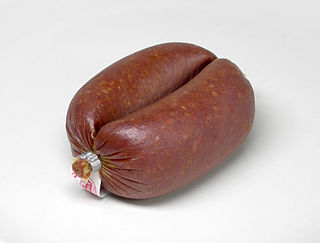 W
WSujuk or sucuk is a dry, spicy and fermented sausage which is eaten from the Balkans to the Middle East and Central Asia. Sujuk consists of ground meat.
 W
WTavuk göğsü is a Turkish milk pudding made with shredded chicken breast. It was a delicacy served to Ottoman sultans in the Topkapı Palace. It is today considered a signature dish of Turkey.
 W
WTorshi are the pickled vegetables of the cuisines of many Balkan and Middle East countries. The word torshi is ultimately derived from Persian torsh, which means 'sour'. In Turkic languages such as Turkish and Azerbaijani it is spelled turşu.
 W
WTripe chorba is a chorba (soup) made with tripe. It is widely considered to be a hangover remedy.
 W
WTulumba or Bamiyeh is a deep-fried dessert found in Iran and the regional cuisines of the former Ottoman Empire, and ultimately originated in the Levant. It is a fried batter soaked in syrup, similar to jalebis and churros. It is made from unleavened dough lump given a small ovoid shape with ridges along it using a pastry bag or cookie press with a suitable end piece. It is first deep-fried to golden colour and then sugar-sweet syrup is poured over it when still hot. It is eaten cold, and is traditionally served for Chanukah and other special occasions by Turkish, Israeli and Persian Jews
 W
WTurkish coffee is a style of coffee prepared using very finely ground coffee beans without filtering. Despite the name, the style originated in Yemen and was brought to Turkey during the period of Ottoman rule. Turks themselves used to call “Turkish coffee“ Arabic coffee since it came from an Arab territory. Today such coffee is sometimes referred to as “Arabica”, referring to coffee that grows in mountainous farms in Yemen.
 W
WYahni, (Turkish), yahniya, or yakhni is a class of foods originating in Asia, found in many countries of southern Asia. It was later introduced to several countries in the Balkans.